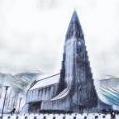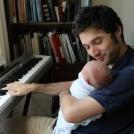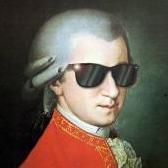Leaderboard
Popular Content
Showing content with the highest reputation on 10/30/2020 in all areas
-
Hello again, friends. I've been in sort of a composing funk for the past few months, lots of life stressors and, really, an utter lack of motivation to blame. I was hoping to write something on a grander scale but I had to settle for solo piano once again. You know what they say: beggars can't be choosers. This is the opening prelude to what will likely become another suite for piano. It's written in harmonic language derived from non-heptatonic scales (my favorite, as some of you know by now), and, as such, may sound unpleasantly dissonant. The chords are quartal or quintal rather than triadic, and there's no sense of a home key. It can't quite be classifed as atonal, however, because the note pitches do play a functional role; it is probably best described as modal, which presents a listening experience unusual to ears familiar with tonal harmony. Nevertheless, I hope you find it enjoyable, or at least appreciable. Feedback and comments are always welcome (so are any questions you may have)! Please, enjoy!2 points
-
Hi everyone! After 9 months, extensive editing and reworking, I have finally finished my full quartet! I tend to compose based on motifs and melodies, so I tend to reuse my motifs and musical ideas throughout the piece with the intention of a coherent flow throughout this quartet. The order is as follows: 1. Allegro Con Spirito in 12/8 time (7'45") Form: Conventional Sonata Form Introduction in D Major -> 1st Subject in D Minor -> 2nd Subject in A Minor -> Development and New Material in A Major -> Recapitulation of 1st Subject in D Minor -> Coda using fragments of 2nd Theme in D Minor The opening movement of the piece, the first movement sets the tone of the piece with its flowing nature, seamless transitions and exploration of its two subjects, with motifs used to keep its coherent flow. The piece starts off with a slow introduction further elaborated on in the 4th movement. I decided to use a early Romantic style of composition with 20th century elements. Dialogue was emphasised throughout the movement with a lot of imitation and antiphonal texture between instruments used throughout the piece. In addition, I explored the varying planes of tones throughout the piece, from choral-like segments to more polyphonic areas. Motifs used: 1-quaver-4-semiquaver rhythm, Melodic pizz. motif, offbeat quavers, Chromatism 2. Adagio Molto Rubato in 2/4 time (11'32") Form: Free Form The slow movement of the piece, the second movement sets out by exploring the contrasts between varying emotions and textures and the use of solo instruments in the scoring of a string quartet, where every instrument has their own cadenzas and solos dotted throughout. Each instrument was given its time to shine and play its own solos and melodies, with interspersing those moments with polyphonic instrumentation and texture typically associated with the quartet. Each main melodic phrase starts off with the fast lively piu mosso section before going into more sentimental, slower sections of the piece. The theme of the piece and main melodic material in the movement recurs periodically throughout the piece with variation and changes in instrumentation and tone colour. I also used a relatively contemporary technique where different parts of the melody and countermelody are played by different instruments in the same phrase. Motifs: Tremolo, Dotted-crotchet-2-semiquaver rhythm, Solo cadenzas and melodies, offbeat semiquavers 3. Scherzo, Molto Vivace in 3/4 and 4/4 time (4'59") Form: Rondo Form A Section in D Minor -> B Section in F Major/B-flat Minor -> A Section in D Minor, -> C Section in F Major -> Cello Cadenza in D Minor -> A' Section in D Minor -> Coda in D Minor The Scherzo of the quartet heavily makes use of quartets and further explores the fugue and unconventional choral-like textures for the quartet. With heavy use of the lively and catchy theme, interspersed with the chromatic fugal style of the other sections, it creates sharp contrast and variety in sound. I utilised very lyrical and easy to latch onto melodies to make this rondo much more memorable and enjoyable, with its fiery unison main theme and its fast liveliness especially accentuated by its running notes as countermelodies. Motifs used: Chromatism, quaver-2-semiquaver rhythm, ascending scales 4. Adagio - Allegro Con Fuoco in 4/4 time (8'07") Form: Rondo Form Introduction in F Major-> A Section in D Minor -> B Section in D Minor -> A Section in D Minor-> C Section in D Major -> D Section in A Minor -> Brief Recap to Introduction -> B Section in D Minor -> Combination of C and D Section in A Minor -> A Section in D Minor -> Coda in D Minor Th final movement of the quartet is very virtuosic and technically challenging with its fast running notes and sudden tempo changes, with the emphasis of unpredictability, rage and contrast as I was composing in mind of the COVID pandemic. The theme throughout remains constant to provide a sense of grounding in an otherwise chaotic and unpredictable piece, with the 3 other main melodic ideas varied through variations and instrumentations. It heavily uses cyclic form in its introduction and coda, bringing ideas from the first and third movement into the forays of the final movement. Motifs: Chromatism, Running Note Scales, Quaver-Crotchet-2-semiquaver rhythm, quaver pizz., melodic motif bridging sections, Arppegio running Notes I would greatly appreciate any feedback given towards the composition as it helps me improve my skill in composing. Feel free to leave suggestions in the comments. Thank you!1 point
-
Thank you so much for your honest review, and for taking the time to listen! Your comments mean more to me than you probably realize... When I play these works for friends and family, their response is much the same as yours: it evokes fear and anxiety, almost as if it were the soundtrack from a horror flick. I promise you, I wasn't writing this to scare anybody, lol. I do wish I understood why these chords elicit unease in some people but not in others. To me, these sounds are emotionally stirring, almost poignant. There is a sense of longing found in the dissonance, as if the music can't find the happiness it's looking for. Above all, though, I find these chords to be full of color. They're rich and they're vibrant, like color that's alive and moving. It isn't the random chaos of atonal music (which holds a different kind of intrigue for me). These notes are carefully chosen from a palette of 8 notes, then combined in ways to enrich the senses, to create a musical color scheme for the ear, so to speak. (At least, that's my intent.) The symmetry here is also beautiful, at least to me. Or... I could just be crazy. 😜 I own that this music sounds weird, and I don't think for a second your reaction is invalid. You have your tastes, which are just as important as anybody else's! Thanks again for giving this a listen. It means a lot!1 point
-
Very nice. This kind of harmony it's natural to me. I think it's a mistake talking all the time about consonance and dissonance. In fact, in these (and all) languages it's a matter of tension and relief, and COLOR. On the other hand, when you take or build up a scale and use it to write a piece like this, it's not atonality. Better, as you said, modality. it's just a mode you have chosen, and you make believe it's real and coherent. And it sounds genuine, unique. The parts are convincing.1 point
-
Not my usual cup of tea but its a fine brew nonetheless. The dissonance is harsh but not to the point that I cant listen. The bass feels creepy at times and the right hand chord stabs really convey a sense of fright. The melancholic moments help balance the anxiety really well.1 point
-
Darren, thank you very much, I really appreciate your sincere feelings and words. I also saw your flute minuet in D and I really liked it. No doubt you love music and have the ability to make your music better and better.1 point
-
1 point
-
ok thank you! Will take note of your feedback and make some changes! Really appreciate your critique!1 point
-
1 point
-
I'm happy to give feedback regarding the first movement, hopefully will analyze the others as time allows. First off, I have to congratulate you on achieving something of this magnitude! It's evident you know your way around the strings, and successfully writing a string quartet is no small thing. It is, in fact, a form I've not yet attempted because it seems so daunting. Hats off to you, sir! Now to my comments... One of the things that grabs my attention immediately, even before listening to the work, is your use of polyphony with these instruments. There is nothing wrong with double- and triple-stops, of course, but I daresay you overuse them, mostly to double notes in chords. (The opening chord, for example, spans 4 Ds, with both the cello and V2 also hitting an F, when the same chord could be achieved without the use of polyphony.) Because of the attack angle required, striking more than one string and sustaining the note lessens the force—not a problem with softer dynamics, perhaps, but it's good to bear in mind that strings are not a piano: more notes don't always equal more volume. Incorporating stops into a work for strings increases the technical difficulty tremendously, particularly if the players are required to hold out such stops. This is not to say that your work isn't playable—I believe it is, for the most part—but it might deter someone from giving your work the live rendition it deserves. Just my thoughts, and I could very easily be wrong about all this. The score has been very carefully engraved; the amount of time you've spent on this and the level of detail you've achieved are astounding, really. Very, very good! In terms of spacing, it might prove more useful to add just another inch or two between systems. I got lost several times in the score because I jumped one too many staves. Your articulations might be a little overboard. For example, in meas. 7 (and beyond), you have the cello playing both staccato and accented while at p dynamics. The effect you're looking for could be better realized with just a staccato technique, since the continual accented notes will make the cello a bit louder than p. A similar thing happens with the viola in meas. 9, where you have both a tenuto and an accented note. I think one or the other should suffice. Anyway, these double articulations continue throughout the work. As a conductor or musician approaching this, my impression is that the composer doesn't understand the subtleties of the instruments he's writing for. Plus, it tends to clutter up the score with superfluous markings. These are not egregious issues, of course. But it might behoove you to dial back in future works. 🙂 Your bowing looks good. Slurred passages seem to be carefully considered for playability. Good going! In meas. 17, you employ both upbow and downbow markings for a single note. I've not seen this device used before, and it seems to defy intuition. (However, I'm not the most knowledgeable person out there, so if it's an established notation, forgive me for bringing it up.) Musically, this work is amazing! You've created some very good and catchy melodies and strung them together seamlessly with transitional passages that are both challenging and fun to play. Plus, you've spread out the "fun" for all the instruments, not just the violins (as is usually the case). My single complaint with this movement is the recapitulation. It looks to be a verbatim replica, and I would've preferred it be in a different key than the original, or at least changed up a little. The coda is nice and exciting, a perfect ending (in my opinion) to your opening movement. I know I've pointed out a lot of potential problems, so I want to finish out by emphasizing what a phenomenal job you've done. This is quite an achievement, and took (I'm sure) hours and hours of dedication and perseverence. I am very impressed. Hopefully, I'll have time to look at the other movements later...1 point
-
1 point
-
Thank you so very much for the feedback! I completely agree about the variations not really sounding anything like the theme. I really went back and forth about whether I should even call them variations, or come up with some new term like "inspirations" or whatever. This is hard to describe in words: I wanted to take the hope contained in Mazurek Dąbrowskiego, and create variations on that. In other words, the variations are not so much variations on the musical theme (melody) itself, but instead on the theme of the music: the idea that something that seems lost is actually not yet lost, a hope for the future, a hope that we can build something worth building. That's what Mazurek Dąbrowskiego expresses, and that's why I chose it, not because of the melody. I took the melody in the theme and dismantled it, and sprinkled the component parts throughout my variations, but you're right on the mark that the variations don't sound like the theme. But they do express love, hope, excitement, eagerness, etc. That's the reason why, in the end, I still called them variations... even though I knew that's not really what they are. I really appreciate your thoughts! Cheers!1 point
-
I think I enjoyed reading about the musical journey as much as I did listening to it! I discovered your blog and couldn't help but read entry after entry. You are (apparently) also a gifted writer of words as much as you are a writer of music!1 point
-
I am so thankful that you took the time to listen through the whole piece, especially because right now I only have computerized audio. Thank you for investing your time in my music. You are so right about the disjointed nature of each movement in relation to the others. I struggled with that as I was working on this... started to get the feeling that I was putting too much content into this music, trying to stuff too much meat into the sausage until finally it just looked unseemly. When I started out writing this, I certainly did not intend for each movement to clock in at 20 minutes, but I think the music got away from me. I just wrote and wrote and wrote until I had said everything I wanted to say, but definitely at the expense of advanced planning. The music quests and wanders and goes where it wants, and as a result the movements start to feel like independent pieces on their own... I suppose I was controlled by the music rather than controlling it. Once it was all done, I looked back over the whole thing, and said to myself, "I'm glad I wrote all this, because clearly there was something in my brain/heart that had to come out, but the next thing I write is going to be more compact, more planned, more cohesive." It's all about learning lessons as you go! Thanks again for listening!1 point
-
Well - I do like Bartok actually, it's just that his solo piano works and chamber works are horrible for me (I deplore his string quartets!). I mostly enjoy his orchestral music however. Just saying I think this prelude of yours could benefit from an orchestration which would also possible increase my enjoyment of it if done well.1 point
-
Bartok is an idol of mine... I appreciate the likening! Thanks for taking the time to listen and provide a review—I know this isn't typically what you like to listen to.1 point
-
This reminds me of Bartok. Although the themes and harmony are mostly dissonant - this has it's moments of relative consonance which I enjoyed (the B section). Thanks for sharing!1 point
-
Nice job! I like the deceptive cadence and phrase extension you added to the end of the B section. The contrast between the staccato and legato sections is effective as well. The only thing is that I expected the B section (staccato) to go on for a longer time before the recapitulation of the A section (legato) came back. The proportions between the time spent on the A and the B material is totally skewed in favor of A. Seems like you should spend more time on the contrasting section. Just a thought. Thanks for sharing!1 point
-
That's confusing. I thought harmony = vertical ordering, melody = horizontal developing. I understand harmony in a much broader sense. Before the common practice period there was 1000 years of modal harmony. "Rules" about harmony change from period to period. 20th century brought many different, and new ways to organize harmony. Whenever there are two pitches, there is harmony.1 point
-
Yes, it sounds like your understanding is correct. Harmony can be thought of as how horizontal—or thick—the music is, while the melody represents the music's verticality—how long it is, if you will. Typically, harmony appears in music as a chord or part of a chord, just like you mentioned. A melody without harmony can tell a story, but adding harmony gives it much-needed context and better informs the ear as to the feeling trying to be conveyed (if one is trying to be conveyed): sadness, melancholy, anger, disgust, horror, mystery, and so forth. Over the last few centuries, beginning in the mid-1600s, harmony in Western music (that is, the music of Europe) has been studied and used extensively, and certain harmonic "rules" were developed. It was expected that composers produce music that obeyed these rules; this is referred to as the Common Practice Period, or CPP, and it lasted until the early 1900s. The harmony that came from this period, and which is still widely used today, is called tonal harmony, or common practice tonality—it is the basis from which we get our 24 major and minor keys. But if you want to understand tonal harmony, I suggest you master notes and scales first. I should tell you that there are many schools of thought on what the purpose of harmony in music is, or should be. If you're interested in creating music that sounds "good," like the music of Mozart and Vivaldi (which I suspect you are), then any online music theory resource ought to be useful. Here's one: https://www.earmaster.com/music-theory-online/course-introduction.html I hope this helps! Feel free to ask more questions as you have them.1 point
-
And again... you make my mind go "simply music..." Made a poem, since i like poetry and I love your music: Music... this sound that comes to my heart from the silence, I feel calm, emotion, passion, the color I smell, I see how it tastes, I touch its sound, brings me reminiscence... How is that I feel, the liberty, when inside of this shell? Falls, on the ground, is that a meteor, is that a star? It doesn't shine, what is it, but a cold try? A try of fantasy, a prelude to that sonata that starts It doesn't shine, but it enlightens me I won't lie, It fugues my imagination, it opera-tes my heart, "Lieder Ohne worte" in the sound, "reflets dans l'eau", without light. Running birds in the sky, (along that ascending ban run) Feels like swimming on this air, Raining seas keep it dry, Might be drowning on this afair, What's this feeling? Is magic right? What fell off was my torment, What shines are my eyes, Are my words the ones that fly, Are my breaths the ones that augment, Are my tears the ones that fight, What's keeping them? Eyelids that unzip, Brain that opens, jail let's free my mind, I wanted to remember, memories rewind. What's this feeling? Is that... MUSIC? (mind I did my best with my english level, if I could use spanish I would have done a cultured one).1 point
-
A minuet for solo flute. I thought about adding a cello accompaniment which I may do later.1 point
-
1 point
-
Wonderful!! I wish I could compose like this! You use the full pallete of colours of the piano to evoke beautiful imagery, or perhaps a reflection of the feelings you have in nature. Its very human.1 point
-
1 point
-
1 point



.thumb.png.8b5b433a341551e913a34392660bc95b.png)



